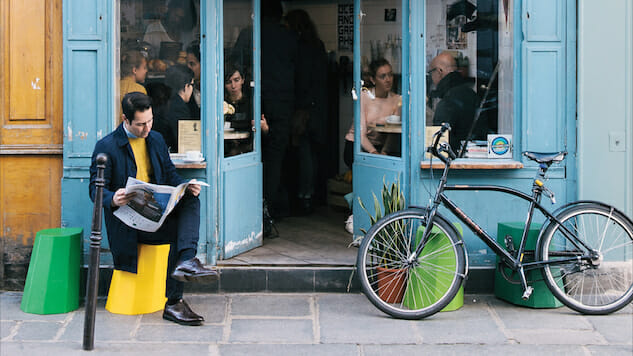
When you think of Paris, what comes to mind? Accordion players, berets, men on bicycles carrying baguettes…
OK, so maybe you know that some of these stereotypes are now obsolete, but what many visitors to Paris don’t realize is that there are many other pervasive misconceptions of the city. For example, café culture is still very much alive, but the coffee, at least at most corner cafés, is bitter and burned. Brasseries, which used to be great for cheap, delicious meals, are now neither cheap nor delicious. And while France is still one of the largest wine producers in the world, cocktails and craft brews have finally arrived in the French capital.
Exploring these trends and more is the goal of The New Paris (Abrams, April 2017) by Lindsey Tramuta, founder of the food and culture blog Lost in Cheeseland.
“Everyone recycles old Paris, the old, timeless, mummified Paris, which is beautiful, and it’s great, but it’s, like, a fraction of what’s really happening here,” she says.
A self-proclaimed “die-hard Francophile,” Tramuta first moved to Paris 10 years ago, and while she is now a French citizen, she still has the curious outlook of an outsider, which may be what makes her so well-positioned to comment on the changes currently taking root in the city. She clearly has her finger on the pulse of change in Paris, exploring the fascinating revolutions currently taking place in food, pastry, coffee, cocktails, beer and design, while also taking into consideration the rich history of the capital.
Despite its locked-in-time reputation, Tramuta explores in the very first pages of her book the ways in which this city has actually often been considered at the forefront of change, “the ultimate model of modernity,” as she says.
“Whether it’s architecturally or gastronomically, Paris has had ups and downs, and this is very much what I feel like is an upward expansion,” she says. “It’s going to continue evolving, but certainly I wanted to touch on this moment, because it’s not about what’s trending, it’s really about people consuming what they’re interested in, and I think that’s more sustainable than a trend.”
As far as restaurants are concerned, for example, Tramuta begins in the late 19th century, exploring the origins of the bistro and brasserie before guiding readers through the unfortunate and widespread mediocrity of the 1980s and 1990s, to finally arrive in today’s era, where young, entrepreneurial chefs are reinstating these traditional categories of restaurants for what they are meant to be: beacons of simple yet excellent home-style cooking.
In the world of coffee, Tramuta focuses first on the partnerships that forced cafés to get their bean supply from an omnipresent monopoly that sells nearly burned Robusta beans before introducing the young people inspired by the coffee cultures of the United States, the UK and Australia to create the excellent coffee shops that have now flooded the capital.
The changes happening in Paris may not seem that strange to residents of other bigger cities, but it took Parisians a bit longer to latch on to these contemporary trends.
“Paris was falling in the ranking of good food,” says Tramuta, who notes that while expensive, gastronomic cooking was always good, the more affordable food options were few and far between, at least as far as quality was concerned.
“I think that before, Parisians were just kind of complacent and settled for whatever was already there, like crappy burgers and crappy whatever, and suddenly you had people who were like, ‘No, why aren’t we doing this better?’”
Tramuta attributes the sudden change to a variety of factors—the sudden albeit late adoption of social media as well as a new interest in travel amongst younger French people.
“I just feel like it opened up a whole new world,” she says.
The book is not designed with the first-time traveler in mind. “Those people should absolutely go to the Eiffel Tower,” she says.
“I was thinking of the person who either loves following things happening in Paris and may not come all the time, but knows enough where they want to know more, and then, of course, the traveler coming all the time.”
But you don’t need to come to Paris to appreciate this book. While there is an incredible appendix in the back of fantastic foodie spots to try, the history and photos make this book worthwhile for any Francophile.
Emily Monaco is a born-and-raised New Yorker based in Paris. After many years of trying, she has come to the conclusion that she will likely never be French. She writes about her experiences with Franglais and food on her blog, tomatokumato.com. Follow her on Twitter